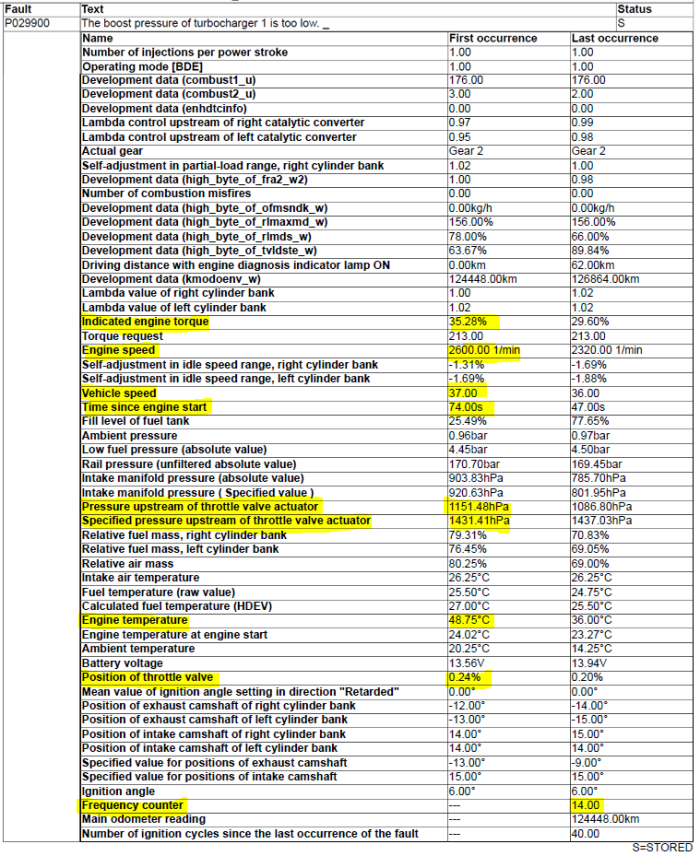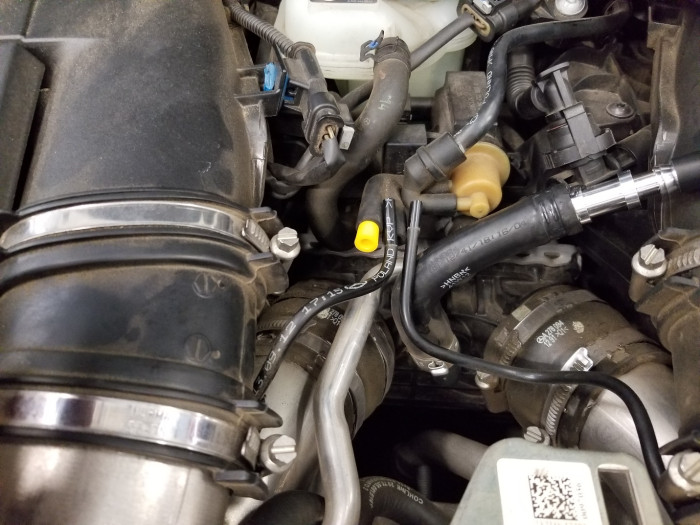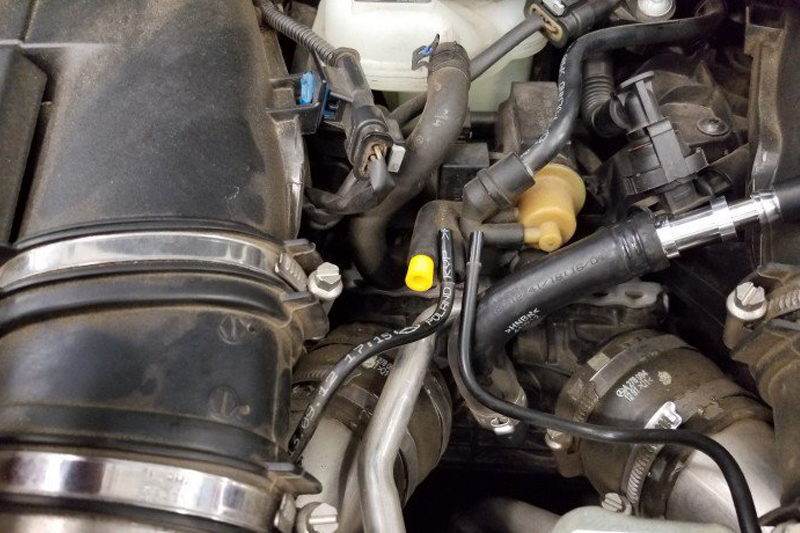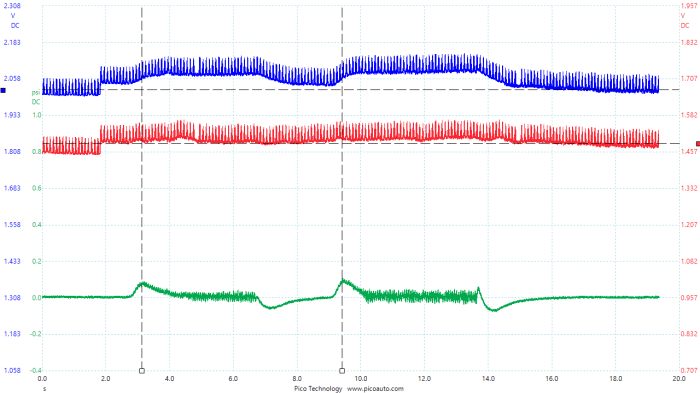Scott Baylis of the Von Housen Automotive Group, looks at a Mercedes GL550 with the engine malfunction indicator illuminated.
This vehicle came in with the engine malfunction indicator lamp (MIL) illuminated. Using our Xentry diagnostic scanner we found diagnostic trouble code (DTC) P029900 was stored in the engine control module (ECM). Our first step was to find out the criteria required to trigger this fault code.
Unfortunately the criteria that was required to triggering this fault code was not listed in Xentry, so we sent a request for this additional information. We found that this DTC is set when boost pressure is not within a determined range. The next step was to look over freeze frame data. It is worth noting here that the ECM is unable to identify whether the low pressure is related to turbocharger 1 or 2, so the description below is not necessarily pointing to low output on one side.

In the freeze frame data we found one value that seemed to be related to the fault code description. The pressure upstream of throttle valve actuator was at 1151.48 hPa, but the specified pressure value was 1431.41 hPa. This told us that the vehicle was producing 280 hPa less boost than requested. Looking at vehicle speed, coolant temp, time since start, engine torque and throttle position helped us to determine what conditions we are going to have to drive the vehicle under to simulate the failure on our road test later.
Here are some technical details of the boost control system on the M278 engine. Firstly, it is a bi-turbo V8 engine where both turbochargers are fed via exhaust manifolds on their respective sides. The turbochargers use vacuum generated by a vacuum pump and a reservoir to control the wastegate actuators. The vacuum is supplied via one boost pressure transducer that is duty cycle controlled and tees off to both boost control actuators on turbochargers. With manifold vacuum supplied, the wastegates are both closed via the wastegate control actuators generating boost pressure. If a vacuum leak occurs or the engine management control module wants to reduce power output, the vacuum is released and spring pressure in the wastegate control actuators opens up the wastegates.
We followed all suggested test steps with no failures detected.
Check component ‘Y77/1 (Boost pressure positioner)’ by means of actuation. The actuation was OK.
Possible cause and remedy
- Check component ‘B28/6 (Pressure sensor upstream of throttle valve)’ for dirt.
- Check component ‘Turbocharger’ for obstructed movement.
- Check exhaust back pressure.
- Check charge air system for leaktightness.
- If there are stored faults or customer complaints, check electrical lines and connectors for loose contact and corrosion.
End of test
- Both actuator arms moved smoothly to and from end stop with actuation.
- All pressure sensor readings correct. (Note: We were at sea level for testing).
- All pressure sensors with key on engine off are plausible as compared to atmospheric pressure. At idle the manifold pressure was 343 hPa at idle speed, well within specified range of 320 hpa to 370 hpa.


- Exhaust backpressure within specification on Xentry while driving.
- Checked charge air system for leaks using 300 mbar of pressure and using a smoke machine (no leaks detected).
- Checked all pin sockets for tightness at pressure sensors and engine module.
Since the suggested test steps did not lead to any failures we drove the vehicle with our Xentry diagnostic tools under same conditions as the freeze frame data listed. All values seemed logical and no fault codes were set. The problem seemed to be intermittent and as such the fault code not easily set. It was time to get creative using the PicoScope and see what kind of guided test we could fabricate to compare the turbochargers output to that of another engine without any performance issues. To create boost we had to have a load on the engine. This could be accomplished by doing a short power brake in the stall. Next thought was to open both wastegates then try and close them one by one, monitoring the pressure build up before the throttle actuator.
To do this we had to:
- Disconnect the vacuum lines to turbochargers from the boost pressure transducer.
- Plug off one of the two vacuum ports out of transducer so there is only one vacuum port out of transducer.
- Hook up the WPS500X pressure transducer to the intercooler charge air output pipe (on earlier versions of this engine you could remove plug and install a test port to perform same test, however on the later versions the output pipe goes to the full throttle purge control system).

The PicoScope was hooked up to: charge air port via pressure transducer, manifold pressure sensor signal wire and charge air pressure sensor signal wire upstream of turbocharger.
Next we needed to power brake the vehicle safely, with the service brake, emergency brake and tire chocks applied. We held the engine speed at 1800 rpm and plugged one turbo wastegate vacuum line for three seconds then removed and plugged second turbo wastegate vacuum line for the same amount of time. Using a two second per division setting on PicoScope we were able to record both turbocharger waveforms on the same frame. There was an obvious difference when comparing the turbo output left to right.
With the low-pass filter function set to 30 Hz for both pressure sensors, and amplifying the signal 8 times it made it easier to see the pressure sensors reaction to the boost pressure. The first marker shows the left turbo building up pressure and the second marker shows the right turbo building up less pressure.
Zooming in on pressure transducer reading you can see the difference side to side even better. The right side turbocharger is not building up as much pressure indicating the wastegate actuator on the turbocharger is not fully closing or the wastegate itself has a mechanical defect causing it to not fully seat. Comparing the movement of the arms side-to-side it leads us to removing the turbocharger to inspect the wastegate.

With the turbocharger removed we could see the wastegate bushing was completely worn out causing it not to seal properly. Creating this 30 minute PicoScope test created a simple way of confirming or eliminating a possible wastegate issue on the turbo. It also isolated which turbocharger had a failure saving the shop from replacing both units. In this case we replaced the right-side turbo assembly.
To have a known good pattern we decided to perform the same test on a known good vehicle and you can see below the patterns are identical from the left and right turbochargers.














